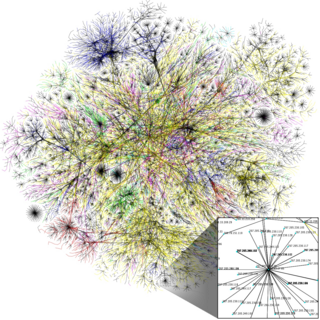
Computing is any activity that uses computers. It includes developing hardware and software, and using computers to manage and process information, communicate and entertain. Computing is a critically important, integral component of modern industrial technology. Major computing disciplines include computer engineering, software engineering, computer science, information systems, and information technology.

The history of the Internet begins with the development of electronic computers in the 1950s. Initial concepts of wide area networking originated in several computer science laboratories in the United States, United Kingdom, and France. The U.S. Department of Defense awarded contracts as early as the 1960s, including for the development of the ARPANET project, directed by Robert Taylor and managed by Lawrence Roberts. The first message was sent over the ARPANET in 1969 from computer science Professor Leonard Kleinrock's laboratory at University of California, Los Angeles (UCLA) to the second network node at Stanford Research Institute (SRI).
Internetworking is "the concept of interconnecting different types of networks to build a large, global network" such that any pair of connected hosts can exchange packets. To build an internetwork, the following are needed: A standardized scheme to address packets to any host on any participating network; a standardized protocol defining format and handling of transmitted packets; components interconnecting the participating networks by routing packets to their destinations based on standardized addresses.
The Internet protocol suite is the conceptual model and set of communications protocols used in the Internet and similar computer networks. It is commonly known as TCP/IP because the foundational protocols in the suite are the Transmission Control Protocol (TCP) and the Internet Protocol (IP). It is occasionally known as the Department of Defense (DoD) model because the development of the networking method was funded by the United States Department of Defense through DARPA.

Streaming media is multimedia that is constantly received by and presented to an end-user while being delivered by a provider. The verb "to stream" refers to the process of delivering or obtaining media in this manner; the term refers to the delivery method of the medium, rather than the medium itself, and is an alternative to file downloading, a process in which the end-user obtains the entire file for the content before watching or listening to it.
In computing, a file server is a computer attached to a network that provides a location for shared disk access, i.e. shared storage of computer files that can be accessed by the workstations that are able to reach the computer that shares the access through a computer network. The term server highlights the role of the machine in the client–server scheme, where the clients are the workstations using the storage. It is common that a file server does not perform computational tasks, and does not run programs on behalf of its clients. It is designed primarily to enable the storage and retrieval of data while the computation is carried out by the workstations.
In computer technology and telecommunications, online indicates a state of connectivity, and offline indicates a disconnected state. In modern terminology this usually refers to an Internet connection, but could refer to any piece of equipment or functional unit that is connected to a larger system. Being online means that the equipment or subsystem is connected, or that it is ready for use.

Packet switching is a method of grouping data that is transmitted over a digital network into packets. Packets are made of a header and a payload. Data in the header are used by networking hardware to direct the packet to its destination where the payload is extracted and used by application software. Packet switching is the primary basis for data communications in computer networks worldwide.
In computing, iSCSI is an acronym for Internet Small Computer Systems Interface, an Internet Protocol (IP)-based storage networking standard for linking data storage facilities. It provides block-level access to storage devices by carrying SCSI commands over a TCP/IP network. iSCSI is used to facilitate data transfers over intranets and to manage storage over long distances. It can be used to transmit data over local area networks (LANs), wide area networks (WANs), or the Internet and can enable location-independent data storage and retrieval.

The Advanced Research Projects Agency Network (ARPANET) was an early packet-switching network and the first network to implement the TCP/IP protocol suite. Both technologies became the technical foundation of the Internet. The ARPANET was initially funded by the Advanced Research Projects Agency (ARPA) of the United States Department of Defense.
The CYCLADES computer network was a French research network created in the early 1970s. It was one of the pioneering networks experimenting with the concept of packet switching, and was developed to explore alternatives to the ARPANET design. The network supported general local network research.
Delay-tolerant networking (DTN) is an approach to computer network architecture that seeks to address the technical issues in heterogeneous networks that may lack continuous network connectivity. Examples of such networks are those operating in mobile or extreme terrestrial environments, or planned networks in space.

A computer network is a digital telecommunications network which allows nodes to share resources. In computer networks, computing devices exchange data with each other using connections between nodes. These data links are established over cable media such as wires or optic cables, or wireless media such as Wi-Fi.

Radia Joy Perlman is an American computer programmer and network engineer. She is most famous for her invention of the spanning-tree protocol (STP), which is fundamental to the operation of network bridges, while working for Digital Equipment Corporation. She also made large contributions to many other areas of network design and standardization, such as link-state routing protocols.
In computer networking, a port is an endpoint of communication. Physical as well as wireless connections are terminated at ports of hardware devices. At the software level, within an operating system, a port is a logical construct that identifies a specific process or a type of network service. Ports are identified for each protocol and address combination by 16-bit unsigned numbers, commonly known as the port number. Inbound packets are received, and the port number in the header is used to decide which application is to be passed the packets.
In computing, the term remote desktop refers to a software or operating system feature that allows a personal computer's desktop environment to be run remotely on one system, while being displayed on a separate client device. Remote desktop applications have varying features. Some allow attaching to an existing user's session and "remote controlling", either displaying the remote control session or blanking the screen. Taking over a desktop remotely is a form of remote administration.
Douglas Earl Comer is a professor of computer science at Purdue University, where he teaches courses on operating systems and computer networks. He has written numerous research papers and textbooks, and currently heads several networking research projects. He has been involved in TCP/IP and internetworking since the late 1970s, and is an internationally recognized authority. He designed and implemented X25NET and Cypress networks, and the Xinu operating system. He is director of the Internetworking Research Group at Purdue, editor of Software - Practice and Experience, and a former member of the Internet Architecture Board. Comer completed the original version of Xinu in 1979. Since then, Xinu has been expanded and ported to a wide variety of platforms, including: IBM PC, Macintosh, Digital Equipment Corporation VAX and DECstation 3100, Sun Microsystems Sun-2, Sun-3 and SPARCstations, and Intel Pentium. It has been used as the basis for many research projects. Furthermore, Xinu has been used as an embedded system in products by companies such as Motorola, Mitsubishi, Hewlett-Packard, and Lexmark.

In computer networking, an elephant flow is an extremely large continuous flow set up by a TCP flow measured over a network link. Elephant flows, though not numerous, can occupy a disproportionate share of the total bandwidth over a period of time. It is not clear who coined "elephant flow", but the term began occurring in published Internet network research in 2001 when the observations were made that a small number of flows carry the majority of Internet traffic and the remainder consists of a large number of flows that carry very little Internet traffic. For example, researchers Mori et al. studied the traffic flows on several Japanese universities and research networks. At the WIDE network they found elephant flows were only 4.7% of all flows but occupied 41.3% of all data transmitted during the time period.
Puneet Sharma is Distinguished Technologist from the Hewlett Packard Laboratories, Palo Alto, CA where he heads Networked Systems group. He started his research career as Research Scientist at HP Labs in September 1998.








